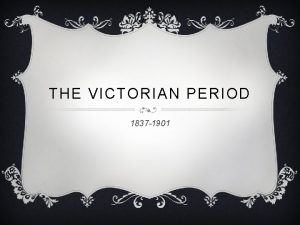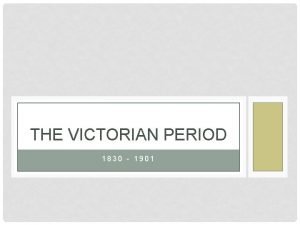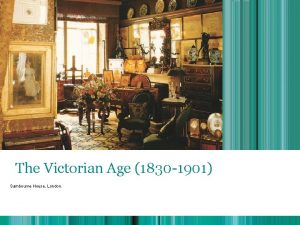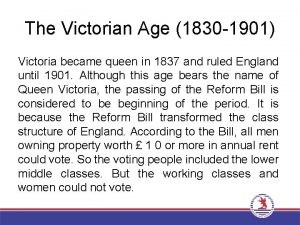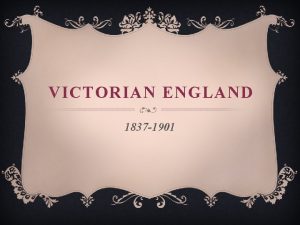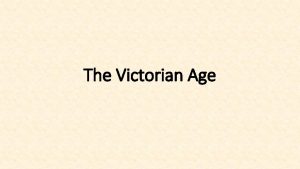Victorian Furniture 1830 1901 19 th Century J






















- Slides: 22

Victorian Furniture 1830 -1901 19 th Century J. Byrne 2015 1

Victorian Furniture 1830 -1901 � Victorian furniture is popular today, probably due to it’s accessibility more than the aesthetics. � Queen Victoria identified herself with the middle class. There was a big demand by the ever-increasing middle class population for this type of furniture. � Mass production using machines led to vast quantities of Victorian furniture being manufactured. � Wood used Mahogany, Burr walnut, Rosewood & Ebony. � Furniture history changed forever through the Victorian period. It became desirable to have a home laden with furniture to show your status to your peers. J. Byrne 2015 2

Victorian Furniture 1830 -1901 � Machines started to replace hand labour, the beginning of the industrial age. � This in turn created a large gap between the designer and the craftsmen. The factories had changed, the designers no longer had direct contact with the customer. � The demand for furniture was high, the factories were manufacturing at a fast pace, and a frantic rush for the designers to keep ahead of each other resulted in poor quality design. � New machines were introduced to speed up manufacture. They soon began to take over most of the work and the furniture started to be designed around what the machine could make, therefore the quality of design declined. � At this stage circular saws, planers and band saws were introduced. Many machines were horse driven, water driven or even man powered. J. Byrne 2015 3

Victorian Furniture 1830 -1901 � The Grecian lines of the Regency Period were replaced by showier furniture with plenty of curves. � This showier furniture after 1850 led to low prices and poor construction and workmanship that was often hidden by veneer and applied ornament. � William Morris started a rebellion against this trend, founding a company to demonstrate the superiority of quality handmade furniture. � Honesty of the hand made joints was his feature of construction. This lead to the Arts and Crafts Movement on the 1880′s leading on to Art Nouveau � This drew attention to the merits of 18 th Century furniture and led to the practice of purchasing second hand furniture and the antique shop began. J. Byrne 2015 4

Victorian Furniture 1830 -1901 � Overall the Victorian period saw the introduction of labour saving machinery which was misused due to high demand which caused a serious deterioration in design and construction. � Features of Victorian Furniture � Cumbersome furniture, dust catching carving. � Buttoned upholstery – armchairs frequently with low arms scrolled at the front. � Balloon & spoon back chairs � Thonet’s steam bent chair. � Ladies easy chairs without arms because the vastness of the skirts. � Chesterfield – fat layer of well sprung upholstery named after the Earl of Chesterfield. J. Byrne 2015 5

Features of Victorian Furniture � Later Victorian easy chairs removed the fully upholstered arms to help lighten up the appearance. Sometimes had a small drawer fitted in the front to hold a spittoon. � Papier Mache chair. Boxes and trays. Papier Mache was applied over a wooded frame for chairs. � Ottomans used in rooms which had bow windows or circular ends and picture galleries. � Smokers bow for houses, barbers shop, cottages and offices. � Work table for games and sewing. Reflects Louis XIV (14 th ) style. � Davenport – lades writing desk. � Chest of drawers with wooden knobs – more to do with cheapness. J. Byrne 2015 6

Features of Victorian Furniture � Chiffoniers used in dining and sitting rooms. � Lootable named after the fashionable card game. � Whatnot suited the over furnished rooms. � Sutherland table – a cross between a gate leg and Pembroke table very narrow, failing in proportion. � Gothic revival sideboard. � Telescopic table – strong steady table with bulbous turning. Solved the problem of leg room. � Sideboard contained back piece of mirror – mass produced in 1840. � Military desk – designed in three parts for travelling, sunken handles. � Brass bedstead – four poster with curtains started to disappear. J. Byrne 2015 7

Duncan Phyfe (1768 – 1854) � Born in Scotland, Phyfe came to New York City in about 1794 and established a cabinet shop. � His firm continued under the name Duncan Phyfe & Sons until 1847, when Phyfe retired, having accumulated a sizable fortune. Phyfe's shop was located at 35 Partition (now Fulton) Street. � Phyfe was one of the first American cabinetmakers to successfully incorporate the factory method into the cabinet workshop. � He employed master craftsmen, & apprentices, as well as carvers, turners, and upholsterers � He introduced the Empire style to New York City. J. Byrne 2015 8

Duncan Phyfe http: //www. metmuseum. org/toah/hd/phla/hd_phla. htm J. Byrne 2015 9

William Morris ( 1834 – 1896 ) � William Morris began as an architect but later took up painting. � He set up a firm along with Philip Webb, Madox Brown, Burne-Jones & Rossetti producing high quality decorative objects. � Morris, Marshall, Faulkner & Co. later became Morris & Co. in 1875. � His textile & wallpaper designs are reproduced today. � Morris disliked machines and believed that Real art had to be hand made. � He was one of the co founders of The Arts & Crafts Movement. � Only the wealthy could afford his products. J. Byrne 2015 10

William Morris ( 1834 – 1896 ) � Morris wrote “ Have nothing in your houses that you do not know to be useful and believe to be beautiful ” � “Art is the expression of man’s pleasure in labour “ � The furniture joints were left visible sometimes even featured, native woods were used mainly oak and often left natural colour. � A lot of Ironmongery was used also. � The Ladder back Morris Chair is thought to have been designed by Philip Webb. J. Byrne 2015 11

Morris Furniture Painted by Morris Chair Image courtesy of Morris society J. Byrne 2015 12

Wightwick Manor Staffordshire Morris furniture, rugs, and textiles. Image Courtesy of Morris Society J. Byrne 2015 13

Philip Webb (1831 – 1915 ) � Born in Oxford, Webb studied at Aynho in Northamptonshire and later moved to London where he met William Morris 1856. � He was the main Designer of Red House at Bexleyheath for Morris. � He became part of the company later known as Morris & Co. � Webb and Morris formed an important part of the Arts and Crafts movement, and founded the Society for the Protection of Ancient Buildings in 1877. Webb also joined Morris's revolutionary Socialist League, becoming its treasurer. J. Byrne 2015 14

Morris & Co. Philip Webb Chair Rossetti Chair Philip Webb Sussex Chair Prenzel - webb J. Byrne 2015 15

Michael Thonet 1871) (1796 - � The pioneer of Bentwood. He developed a technique by which solid lengths of beech could be softened by boiling or steaming & bent into frames. � Thonet patented his process in 1841 and set up business in Vienna in 1842. � He developed his designs until they could be mass produced. � Chair No. 14 comprises only six parts. � He exhibited his chairs at the Crystal Palace Exhibition in 1851 and was so successful that he opened a London Factory. � In 1870 he was turning out 1, 200 daily. � By 1871 his company was the largest furniture-maker in the world. � Rocker chair No. 64, moulded Chair made from one continuous piece of Plywood. J. Byrne 2015 16

Thonet Chairs Chair No. 14 Moulded Chair Rocker No. 64 Lounger J. Byrne 2015 17

Thonet Chairs Flat pack chair No. 14 Taken from Thonet’s Book Chair No. 14 A take on Thonets chair J. Byrne 2015 18

Charles Rennie Mackintosh ( 1868 - 1928) � This outstanding Scottish Architect & Designer was an important influence on the development of Modernism. � With his wife Margaret her sister Frances & her husband Herbert Mac. Nair “The Four ” as they became known established their own style which was not popular in Britain however it was hugely popular on the Continent, Austria & Germany. � He designed from furniture to wall coverings, cutlery to light fittings. � Furniture was based on straight lines and gentle curves using geometric shapes. � His chairs have long straight backs. � Furniture was often painted black or shades of white � He was one of the founders of the Modern Movement. J. Byrne 2015 19

Mackintosh Willow Chair Ash Armchair J. Byrne 2015 20

Mackintosh Writing Desk High Back Chairs J. Byrne 2015 21

References �http: //www. morrissociety. or g/morris/artdecorative. html J. Byrne 2015 22
 Victorian age 1832 to 1901
Victorian age 1832 to 1901 The victorian age 1832 to 1901 unit test
The victorian age 1832 to 1901 unit test Victorian period
Victorian period Victorian age 1832 to 1901
Victorian age 1832 to 1901 Roman period floral arrangements
Roman period floral arrangements History of floral design vocabulary
History of floral design vocabulary Indian removal act of 1830
Indian removal act of 1830 Congressional act of 1830
Congressional act of 1830 Romantic period timeline
Romantic period timeline Liberty leading the people, 1830
Liberty leading the people, 1830 Levitico 1830
Levitico 1830 Who signed the indian removal act of 1830
Who signed the indian removal act of 1830 Candy crush 1830
Candy crush 1830 Liberty leading the people, 1830
Liberty leading the people, 1830 Emily dickinson (1830-1886)
Emily dickinson (1830-1886) Ensayos constitucionales de chile entre 1823 y 1830
Ensayos constitucionales de chile entre 1823 y 1830 I moti del 1830-31
I moti del 1830-31 Indian removal act map
Indian removal act map Indian removal act of 1830
Indian removal act of 1830 Moti del 30 31
Moti del 30 31 United states map 1830
United states map 1830 Liberty leading the people 1830
Liberty leading the people 1830 Map of america 1830
Map of america 1830

























